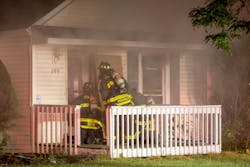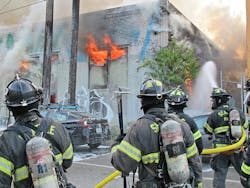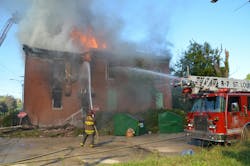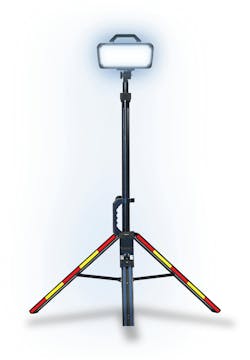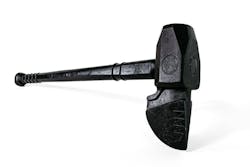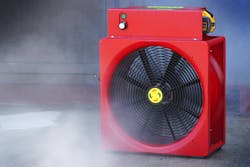Truck Tactics: Vacant Properties: Search or Go Defensive?
The motivation for this column was a recent fire to which my department responded where a squatter was trapped on the third floor of a dilapidated structure. The structure was on my radar for several years and was featured in numerous presentations on size-up and tactics. The large wood-frame structure was converted into several single-room occupancies and was vacant for several years.
The outcome was positive, because the squatter had made it to a third-floor window and companies were able to effect a rescue by ground ladder.
Two approaches
Firefighters face difficult decisions on a daily basis. One of the most complex situations that they encounter is dealing with fires that are in vacant structures and buildings. Although this column focuses on the truck company, these fires are a huge challenge for engine companies as well.
Members of truck companies, with their focus on ventilation, search and rescue, and forcible entry, often are the firefighters who must make the most difficult calls on the fireground. However, when it comes to structures and buildings that are supposed to be uninhabited, the fire response challenge gets even more complicated for these decision-makers.
In today’s economic climate, a growing number of vacant structures and buildings aren’t truly vacant at all. Many are occupied by squatters—people who have no place else to go. This reality raises a critical question for truck company operations: Should the priority be to search the property, or should it be to take a defensive stance and focus on containing the fire from the outside? Both approaches have their merits, and neither is without risk.
One simple argument is rooted in the mission of firefighting: Saving lives is the top priority, regardless of circumstances. Whether a person is living in a structure or building legally or squatting out of necessity, that person deserves to be rescued if they’re in danger. The moral imperative to preserve life doesn’t change because someone is occupying a property illegally.
Search or containment
For firefighters who advocate for a search-first approach, the reasoning is clear: You can’t always know from the outside of a structure or building whether someone is inside. Waiting for definitive proof could cost lives, because fire spreads quickly and victims who are inside might not have a chance to escape on their own.
A fast, aggressive search in the initial moments of a fire response could mean the difference between life and death for people who are trapped inside. Members of truck companies who trained in rapid primary searches can prioritize likely areas where squatters might be staying—bedrooms, common areas or near exits—and can get in and out before the fire grows too intense.
There also is the ethical dimension to consider. Squatters, many of whom live in desperate conditions, might not have access to the same resources and support networks that legal tenants do. These homeless people often are among the most vulnerable members of society, and firefighters might feel a particular responsibility to protect them.
On the other side of the debate, there’s a strong argument for member to take a more defensive approach, particularly when the property appears to be unoccupied. In this view, firefighter safety should be the top priority, and entering a property that’s supposed to be empty adds unnecessary risk for firefighters.
Unless there’s clear evidence that someone is inside—such as visible movement or reports from neighbors—firefighters should prioritize containment. Defensive operations focus on keeping the fire from spreading to neighboring properties and minimizing overall damage, rather than sending crews into a potentially dangerous situation.
Six key factors
There’s no clear-cut answer to the question of whether to search or to go defensive, and the right decision will vary from case to case. However, there are six key factors that fire crews and command officers should consider when they make the decision about how to approach a vacant structure or building fire.
Building condition. If the structure or building shows signs of severe disrepair—collapsing walls, sagging floors or obvious signs of instability—entering the property might be too dangerous, pushing the operation toward a defensive stance.
Fire behavior. If the fire is fast-moving and already compromised a significant portion of the structure or building, it might be too dangerous to enter. On the other hand, if the fire is slow-burning and confined to a specific area, there might be time for a quick search.
Signs of occupancy. Evidence that someone might be inside could justify the risks that are associated with a search.
Availability of resources. In many departments, resources are stretched thin. If there aren’t enough firefighters or isn’t enough equipment to safely conduct a search, the operation might need to be defensive. Command officers must weigh the availability of personnel and apparatus when deciding how to proceed.
Location and surroundings. The location of the structure or building also can influence the decision. In densely populated areas, a defensive approach might focus on protecting neighboring properties from catching fire. In more isolated locations, there might be more leeway to conduct a search without risking the fire spreading to nearby homes or businesses.
Experience and training. Firefighters who have experience with fires that are in vacant residences and buildings might be more comfortable making quick decisions about when to search and when to go defensive. Ongoing training and drills that focus on these scenarios also can help truck companies to make the right call in the heat of the moment.
A hybrid approach
One solution for departments to consider is a sort of hybrid approach that allows firefighters to be flexible and adapt to the specific conditions of each fire.
For example, a truck company might conduct an initial size-up from the exterior, looking for signs of occupancy and/or structural instability. If there are indicators that someone might be inside, a small team could be sent in to perform a targeted, rapid search of the most likely areas, such as rooms that are near the entrances or common living spaces. If the fire progresses or the structure/building is found to be too dangerous, the operation can shift quickly to a defensive posture, to focus on containment and protecting neighboring properties.
This balanced approach gives firefighters the best chance to save lives while still prioritizing their own safety. It also allows departments to adjust their tactics based on the evolving situation, rather than being locked into a single approach from the outset.
Emotional consequences
It’s worth noting that the decision to search or go defensive doesn’t just have tactical implications. It also has emotional consequences for the firefighters who are involved. The mission of a firefighter is to save lives, and leaving a structure or building without conducting a search can weigh heavily on crew members, even when it’s the safest decision.
In cases in which firefighters know that squatters might be inside, the emotional toll can be even greater. These vulnerable people often have nowhere else to go, and the knowledge that a firefighter might be leaving someone behind can be difficult for that member to bear. Increasingly, departments are recognizing the need for mental health support for firefighters who face these kinds of situations.
As housing becomes more unaffordable and homelessness rises, departments likely will continue to see more fires in structures and buildings that are supposed to be empty but aren’t. This calls for not just tactical adjustments but also changes in policy and planning at the department level.
Training
The debate over how to handle fires in vacant structures and buildings reflects the broader challenges that are faced by truck companies and departments today. With more vacant properties being used as makeshift shelters, firefighters constantly weigh the risks of entering unsafe locales against the potential lives that could be saved.
There isn’t a one-size-fits-all solution, and firefighters and their command officers must rely on their training, experience and situational awareness to make the right call in the moment.
Training is vital for preparing firefighters for the unique challenges that are posed by fires in vacant structures and buildings. Truck companies must be proficient in size-up, situational awareness and search techniques that allow them to quickly assess risk while protecting their own safety.
Regular drills that are focused on these types of fires can help firefighters to become more comfortable with making rapid decisions about whether to search or to take a defensive approach. These drills can simulate the kinds of hazards that are common at these fires, such as unstable flooring, electrical hazards and unexpected obstacles.
One way to address the issue of fires in occupied vacant properties is through partnerships with community organizations and housing advocates. By working together, fire departments can help to identify vulnerable populations who might be living in unsafe conditions and connect them with resources to prevent tragedies before they happen.
Some departments already are building these kinds of partnerships that are aimed to provide fire safety education and to identify structures and buildings that are known to be inhabited by squatters. This proactive approach not only improves safety but also helps to reduce the overall risk of fire in these places.
A new reality
In today’s world, truck company operations in vacant structures and buildings have become far more complex than they once were. What was once a relatively predictable fire scene has transformed into a scenario that’s filled with unknowns, as the rise in homelessness and squatting has blurred the lines between “vacant” and “occupied.”
The debate between searching for potential occupants and taking a defensive approach is ongoing, with valid arguments on both sides. On one hand, there’s a moral imperative to save lives, no matter to whom those lives belong. On the other hand, firefighter safety always must be a top priority, and the risks that are associated with entering structurally compromised properties are real and significant.
Ultimately, the decision to search or to go defensive depends on a number of factors, including the condition of the property, fire behavior and department staffing.
By investing in training, technology and community partnerships, departments can better navigate this new reality and protect both the public and their own personnel.
Firefighters and officers should make sure that they stay current on their training and best practices for fires in vacant structures and buildings. The ability to make smart, informed decisions in these high-risk environments could save lives—not just of those people who are inside but of firefighters, too.
PRODUCT SPOTLIGHT
Tripod Light
Command Light’s Trident is the only tripod light of its kind that lets departments choose their power source and firefighter-favorite LED. Pair AC power, truck 12-volt DC battery power, AC shore power or a combination of all three with Akron Revels, FRC Spectras, Radiant Command, FireTech Helios, Whelen PioneerPlus, Feniex Arrow Stick or a Federal message bar. The light can operate off of a variety of battery options: DeWalt, HURST, Makita or Milwaukee.
Heavy Irons Tool
Fire Maul’s TSR edition is a heavy irons tool that’s ready to take on the most difficult forcible entry and demolition jobs. It features the company’s 28-inch Demolish composite sledge-style handle that has integrated lacing rings in the grip area and collar rings just below the tool head. The tool head weighs 9.5 lbs. and is constructed of forged 4340 steel. The wedge-shape blade captures progress, drive and hold thanks to its grooves.
Battery-Powered Smoke Ejector
Super Vac’s battery-powered smoke ejector is a compact, lightweight and reliable tool to add to any department’s arsenal. The 16-inch device can operate for as long as 93 minutes on a full charge while maintaining the same output as other models. The device is made with the versatility to pull smoke from structures using negative pressure or for positive pressure tactics.
About the Author

Sean Eagen
Sean Eagen is a 28-year veteran of the Buffalo, NY, Fire Department. He currently is the captain of Truck 4. Eagen also is an instructor for the New York State Office of Fire Prevention and Control Special Operations Branch. He was a regular presenter at Firehouse's conferences.
